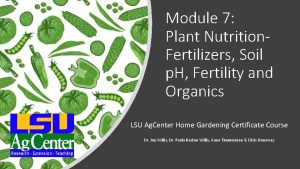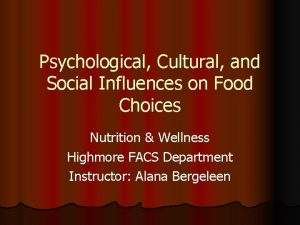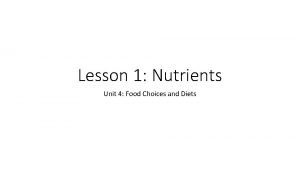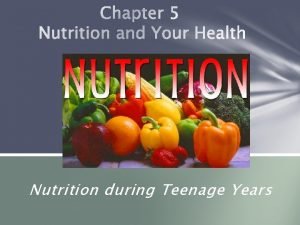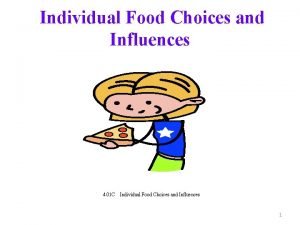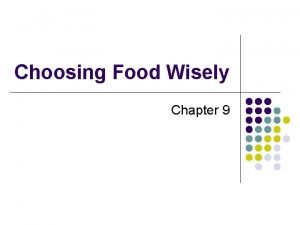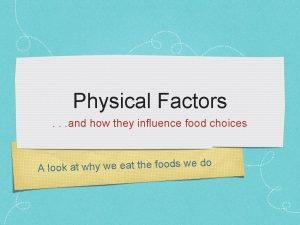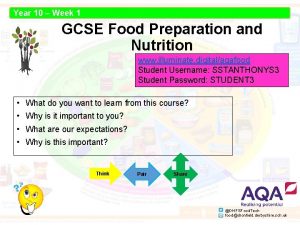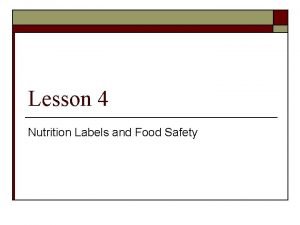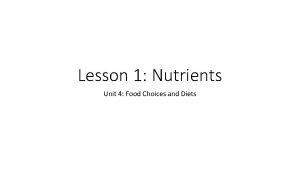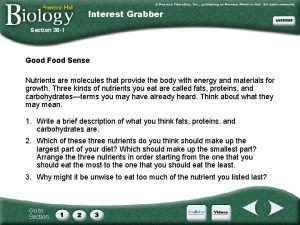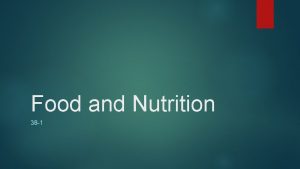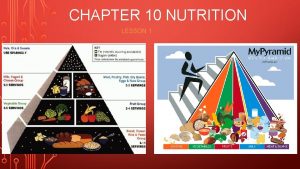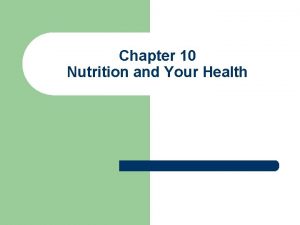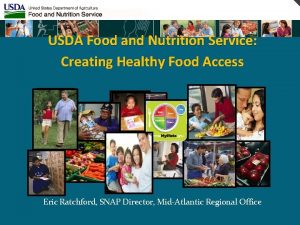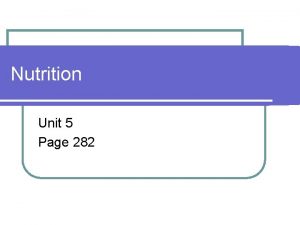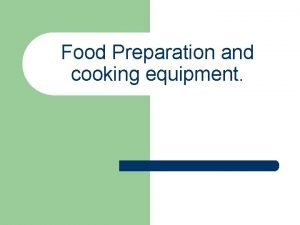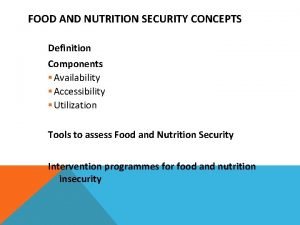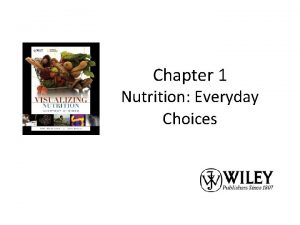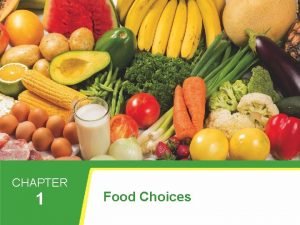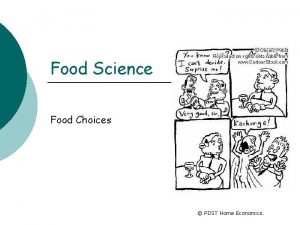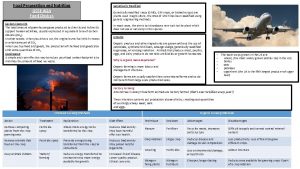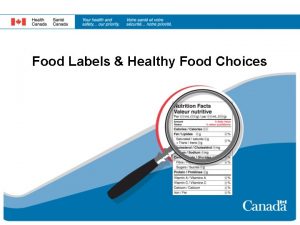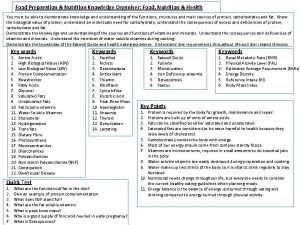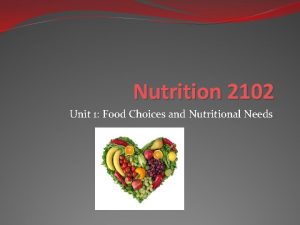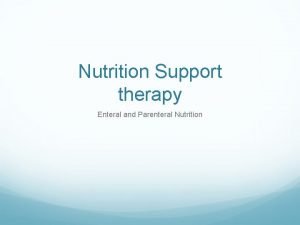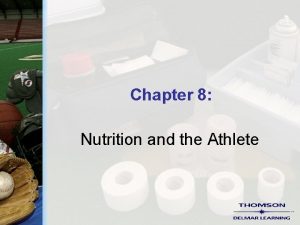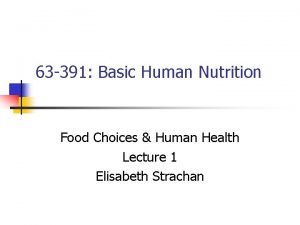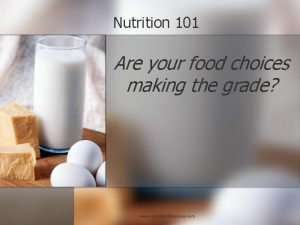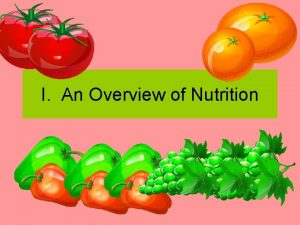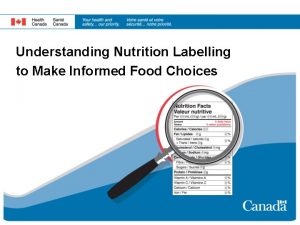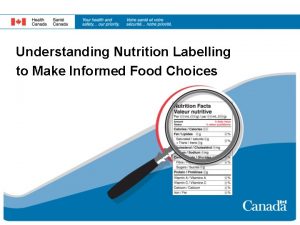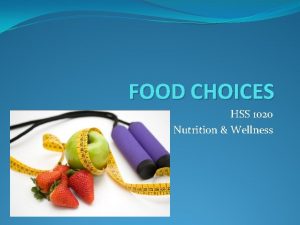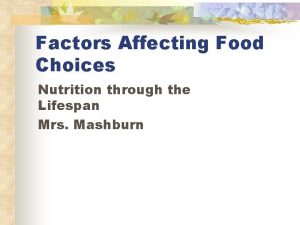Food Science and Nutrition Food choices 1 1
























- Slides: 24


Food Science and Nutrition (Food choices 1. 1. 1)

What you will learn • Factors that affect food choices

Food choices Making healthy food choices has a positive impact on health and wellbeing. Food choices are affected by a number of factors, including: • • • Culture Finance Sensory aspects Nutritional awareness Health status • • Food sustainability and ethics Eating patterns Availability Marketing and advertising

Culture • Certain foods are associated with particular cultures. E. g. __________________________ • Religious beliefs and values affect food choices. E. g. __________________________ • Influences such as travel, immigration, media and advances in food processing impact greatly on food choices in the Irish diet. E. g. __________________________

Finance • Low-income families must choose cheaper nutritious foods to ensure they have a healthy diet, e. g. ________________. • People with higher incomes may eat out and visit other countries more often, introducing them to a greater variety of foods. • Planning meals before shopping for food helps to reduce the risk of food waste.

Sensory aspects • Our senses of sight, smell and touch influence our choices when we shop for food, allowing us to select wholesome food, e. g. ___________________________. • Food samples cooked at promotion stands in supermarkets attract shoppers and may influence their food choices. • The presentation, flavour and temperature of food must appeal to our senses.

Nutritional awareness • Home Economics, government initiatives, e. g. _________, and TV programmes, e. g. ______________, raise awareness of the contribution that good food choices make to a healthy lifestyle. • Organisations such as ______________ ensure that many Irish people know that a healthy, balanced diet consists of a variety of fresh, nutritious foods. • Information on food labels helps people to make better food choices, e. g. __________________________.

Health status • Better food choices help to tackle the problems of obesity and coronary heart disease. • Adequate fibre in the diet is vital to maintain a healthy digestive system and to reduce the incidence of bowel disorders such as ________________. • Food intolerances, e. g. ________, and food allergies, e. g. _______, make careful foods choices a necessity.

Food sustainability and ethics • Many people make environmentally aware food choices, e. g. ___________________________. • Many people are influenced by ethics in their food choices, e. g. ____________________________. • Choosing organic food reduces the contamination of soil and water. • Some consumers are switching to a more plant-based diet, which results in lower carbon emissions into the atmosphere.

Eating patterns • Busy lifestyles require careful planning and preparation so that nourishing meals are not replaced by unhealthier convenience foods. • Healthy eating patterns introduced during childhood help to maintain a healthy weight and reduce the risk of disorders such as ______________. • In households where individual meals are eaten irregularly and at different times, it can be difficult to establish healthy eating patterns.

Availability • When food produced locally is in season, it is flavoursome and nutritious, e. g. ________________________. • Location influences the availability of some foods. In some areas, choice may be limited because there are fewer shops and restaurants. • Our multicultural population means that many foreign and ethnic foods are now available in Ireland, e. g. ________________________.

Marketing and advertising • The marketing industry specialises in persuading consumers to choose particular food products by using appealing packaging and attractive displays. • Advertising constantly encourages consumers to purchase new and improved food products, e. g. _______________. • Social media, cookery programmes and apps influence food choices e. g. _________________________.

Recap Outline the factors that influence our food choices. Give an example of how culture or religion might affect food choices. Explain how our senses might affect our food choices. Which health problems are associated with poor food choices? Describe a current food advertisement/marketing campaign that appeals to you. • How would you encourage people to make better food choices? • • •

Exam focus • See the questions on page 5 of the textbook. • See the Exam and Assignment Journal, pages 41– 42.

What you will learn • Terms used in the study of nutrition

Nutrition Nutrients The study of food – its composition, structure, properties, amounts required and its effects on the body. Substances used by the body to produce heat and energy, to promote growth and repair and to regulate metabolism.

Nutrition • Macronutrients: Nutrients required in large amounts, i. e. proteins, lipids and carbohydrates. • Micronutrients: Nutrients needed in very small amounts, i. e. minerals and vitamins. • Element: The simplest form of a substance. Each nutrient is made up of elements, e. g. proteins are made up of the elements carbon, hydrogen, oxygen and nitrogen.

Nutrition • Organic nutrients contain the element carbon, e. g. proteins, lipids, carbohydrates and vitamins. • Inorganic nutrients do not contain carbon, e. g. mineral elements such as iron and calcium.

Nutrition • Metabolism is the total of all chemical reactions that occur in the body, e. g. growth, digestion. • Metabolic reactions are controlled by enzymes. • Example: Amylase (enzyme) breaks down starch (substrate) into maltose (product). Enzyme Substrate Product Organic catalysts that control the rate of chemical reactions Substance on which an enzyme works The end result of an enzymic action

Nutrition • Antioxidants are substances that protect the body from damage caused by free radicals, which are by-products of metabolism. • Antioxidants help to prevent conditions such as coronary heart disease and certain types of cancer.

Nutrition Malnutrition Undernutrition • Malnutrition is a term for dietary imbalance. • It may occur as a result of too little or too much of a nutrient, e. g. ___________. • Undernutrition results from starvation/when too little food is consumed to supply enough nutrients, e. g. _______.

Recap • Define the terms nutrition and nutrient. • Distinguish between macro and micronutrients and give an example of each. • Define metabolism. • What is meant by an (a) enzyme (b) substrate (c) product? Give one example. • What are antioxidants and how do they benefit the body?

Exam focus • See the Exam and Assignment Journal, pages 41– 42.
 Science my favourite subject
Science my favourite subject Food choices and human health
Food choices and human health Plant nutrition and soil science
Plant nutrition and soil science When making smart food choices what question
When making smart food choices what question Psychological influences on food choices
Psychological influences on food choices Function of niacin
Function of niacin Salty sour
Salty sour A guide for making healthful daily food choices
A guide for making healthful daily food choices Physiological influences on food choices include
Physiological influences on food choices include Evaluating food choices
Evaluating food choices Factors that affect your food choices
Factors that affect your food choices Unit 3 lesson 3 guidelines for eating
Unit 3 lesson 3 guidelines for eating A healthful eating plan can include sensible snacks
A healthful eating plan can include sensible snacks Illuminate aqa food
Illuminate aqa food Datingoo
Datingoo Food and nutrition unit 4
Food and nutrition unit 4 38-2 the process of digestion
38-2 the process of digestion Rda food label
Rda food label 38-1 food and nutrition
38-1 food and nutrition Chapter 10 lesson 4 nutrition labels and food safety
Chapter 10 lesson 4 nutrition labels and food safety Chapter 10 lesson 4 nutrition labels and food safety
Chapter 10 lesson 4 nutrition labels and food safety Usda food and nutrition service
Usda food and nutrition service Food and nutrition unit 5
Food and nutrition unit 5 Labour saving devices in the kitchen and their uses
Labour saving devices in the kitchen and their uses Define nutrition security
Define nutrition security


